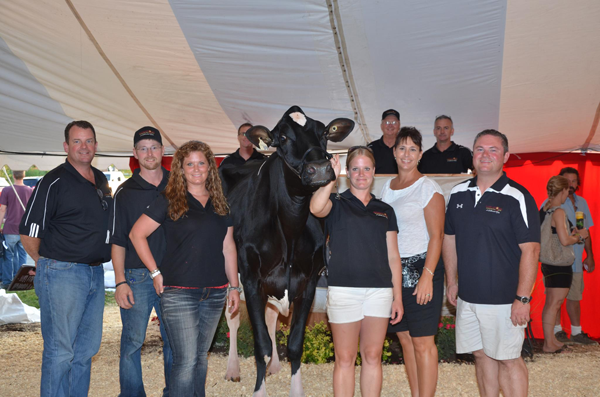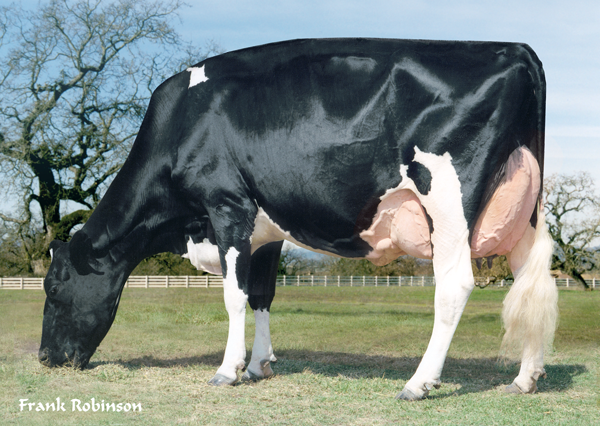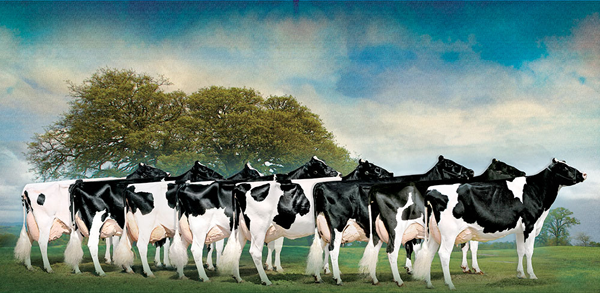Six operations. Three generations. One empty chair. The 2025 Royal Winter Fair just became about more than banners.

Standing in the Quality Holsteins barn earlier this week, watching Ari Ekstein prepare for the 2025 Royal Winter Fair, I felt the weight of what wasn’t there. For over 70 years, Paul Ekstein attended The Royal Winter Fair. This November will be the first without him.
Ari doesn’t talk about it directly. But you can see it in how he runs his hand over the leather lead that’s been in the family for decades, the same one his father used. Paul passed away earlier this year at 91—that unbreakable soul who escaped Nazi-occupied Czechoslovakia as a boy and built one of Canada’s most respected breeding programs from absolutely nothing. Now it’s Ari carrying forward that vision, maintaining the 95% homebred genetics, those 200 Excellent cows they’ve bred together over the years. (Read more: From Czechoslovakia to Quality Holsteins: Paul Ekstein’s Unbreakable Legacy)
“He taught me that attention to every minor detail can lead to major success,” Ari mentioned quietly as he adjusted a show box that’s seen five decades of Royals.

What happened next changed my perspective on this entire show. Ari was sorting through old photographs for the collage we’re creating—decades of Royal Winter Fairs captured in fading prints and yellowed edges. Paul with young champions that would go on to become foundation cows. Moments of triumph caught mid-celebration. Quiet conversations between classes. Each image tells part of a story that spans 70 years. The kind of legacy you can’t download or buy. Just earn, year after year, Royal after Royal.
The Dreams That Drive Them Forward

Ethan, Morgon and Gord McMillan from Kingsway Holsteins are preparing for The Royal next week, carrying their own weight of expectation. In their barn, photos spanning four decades of Royal Winter Fairs cover the walls. Champions from years past. Near-misses that still sting. And somewhere, that one empty space—reserved for a Grand Champion banner that hasn’t come home yet.
Gord has been chasing this dream for longer than Ethan and Morgon’s been alive. The weight of that—inheriting someone else’s dream while building your own—stays with you.
What’s remarkable about their ranking as Canada’s number two breeder of all time for Excellent cows is their surprise when they learned about it. They had no idea. Kingsway markets a lot of heifers and cows every year—animals scoring excellent in other herds, adding to a total they never tracked. That kind of humility, that focus on the work rather than the recognition, tells you everything about who they are. (Read more: The Heart of Excellence: Getting to Know the Family Behind Kingsway Holsteins)
Their foundation cow, Kingsway Sanchez Arangatang, died earlier this year at nearly 15 after producing 18 Excellent daughters. Her genetics now thrive in robotic dairies in Saskatchewan, grazing operations in the UK, and show herds across North America. Her influence keeps spreading, even after she’s gone.
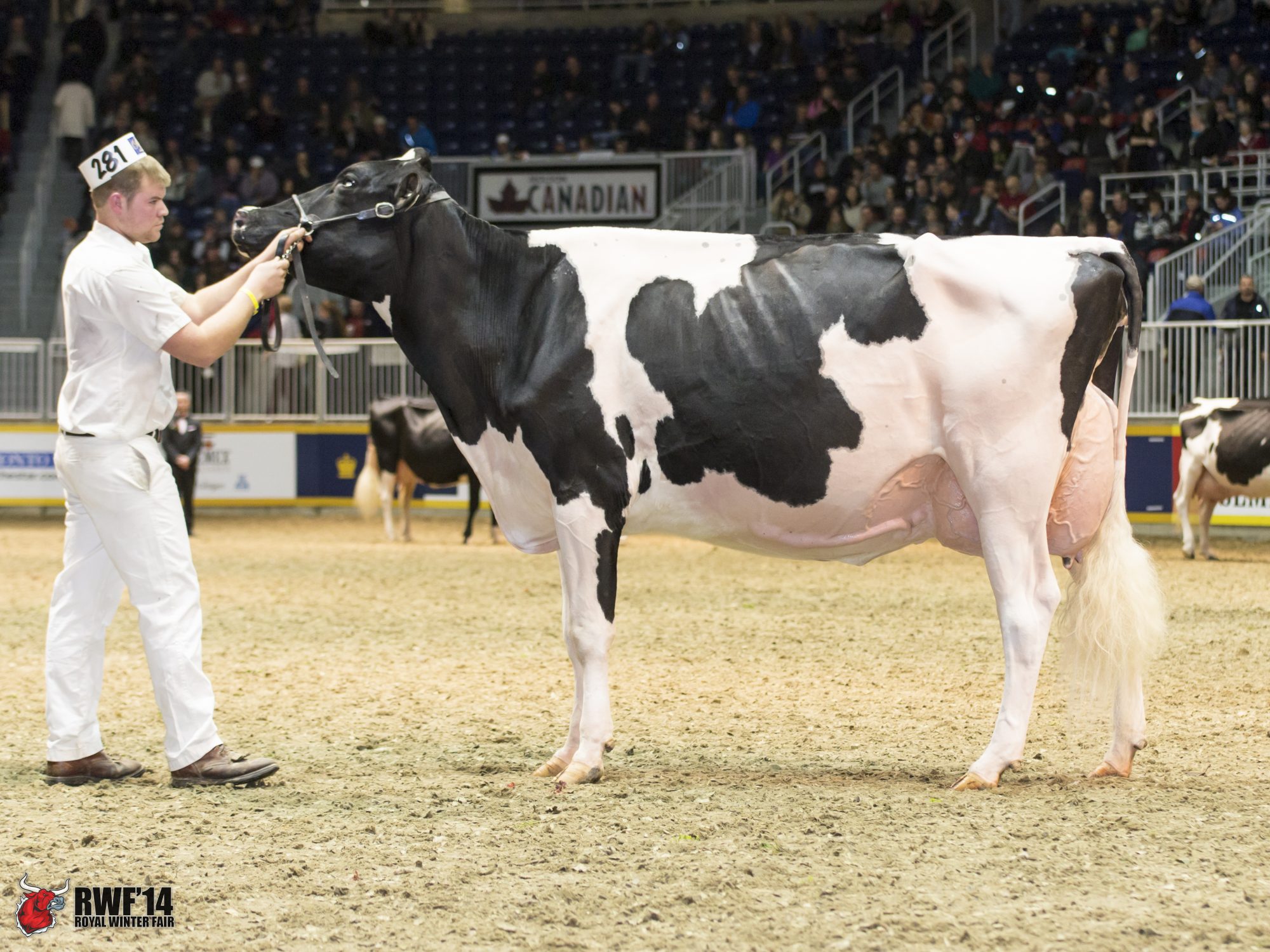
As Arangatang’s granddaughters are prepped for next Thursday’s heifer show, there’s something profound happening. Both Kingsway and Quality are entering The Royal, carrying forward the work of those who can’t be there to see it. That changes everything about what winning means.
The Ferme Jacobs Legacy

Nobody expected what happened at the 2018 Royal Winter Fair.
Ferme Jacobs didn’t just win—they swept both Grand Champion with Jacobs Windbrook Aimo and Reserve Grand Champion with Jacobs Lauthority Loana. Both homebred, both extrodinary in there own ways. The first time any Canadian breeder had swept Grand and Reserve with homebred animals since 1969—a historic achievement that complements their record 11 Premier Breeder banners.(Read more: Ferme Jacobs – “Dreams without goals are just….dreams”)

Jacobs Lauthority Loana: Reserve Grand
Both homebred. NOT sisters. Two different cow families.
First time since 1969.
The moment that changed everything wasn’t the winning, though. It was what happened after. In an industry increasingly obsessed with genomic testing and data analytics, here was old-school proof that traditional breeding wisdom—cow families first, genomics last—still mattered. The Jacobs family refuses to use any bull that’s minus for milk. They never flush cows during show season, believing it compromises the natural bloom judges reward.
Teaching the next generation matters to them. Not just about cattle, but about character. How to win with grace. How to lose with dignity. How to keep going when neither happens.
Their preparations reveal something extraordinary—three generations working together, each with specific roles, nobody needing to be told what to do. This is knowledge passed hand to hand, season to season. The kind you feel in your bones after enough cold mornings and late nights.
Passion as a Business Model

Simon Lalande walks differently than other breeders. There’s an energy, an urgency that makes sense when you understand Ferme Blondin’s reality.
For Simon, the show ring isn’t just competition—it’s the engine that drives his entire operation. With cattle and embryo sales forming the core of his business model, every Royal appearance creates ripples that reach buyers worldwide. His Premier Exhibitor titles at major shows didn’t come from having the deepest pockets. They came from understanding that passion, properly channeled, becomes its own competitive advantage. (Read more: FERME BLONDIN “Passion with a Purpose Builds Success”)
“Success is built on three things,” Simon explained. “Passion, hard work, and perseverance. But passion comes first. Without that, the other two don’t matter.”
That same marriage of passion and business acumen defines Pierre Boulet, who has achieved something extraordinary—more EX-97 cows than anyone in the industry. EX-97 represents near perfection, and he’s done it repeatedly. Like Simon, Pierre has built his operation around cattle sales, understanding that the show ring creates market demand. That’s not luck. That’s a lifetime of recognizing excellence early and systematically developing it. (Read more: FERME PIERRE BOULET: First Comes Love Then Comes Genetics)

Both men have turned their eye for exceptional cattle into thriving businesses where passion and profit reinforce each other. These aren’t just breeding operations. They’re places where dreams take physical form, where excellence becomes tangible in the arch of a topline, the depth of a rib, the walk of a champion.
The Scale of Dreams
The numbers from Westcoast Holsteins sound impossible at first: operations spanning multiple farms across provinces, thousands of milking cows, thousands more young stock.
Excellence could easily get lost in those numbers. Instead, they’ve created systems that identify individual brilliance within an industrial scale. Their elite show prospects live in group housing specifically designed to maintain competitive appetites. It takes a team of dozens, each trained to spot that one-in-a-thousand spark that separates good from great. Even with thousands of animals, they understand that champions need individual attention.

Their past Royal successes prove the model works. What’s remarkable is imagining the logistics—the moment someone in that vast operation noticed one special heifer, pulled her out, and invested months of preparation. That is systematic excellence at a scale that shouldn’t be possible, yet somehow is.
The Moments That Define Everything
Right now, these operations are deep in final preparation. What started eight to twelve weeks ago with strategic feeding programs has evolved into something approaching devotion. As anyone who has aspired to success at The Royal, you know its a 24 hour a day, 365 days a year task.
Earlier this week, a young woman spent 45 minutes working on a single heifer’s topline. Not because anyone told her to, but because she could still see room for improvement. Her grandmother stood nearby, occasionally offering suggestions drawn from decades of fitting cattle. Three generations of knowledge concentrated in one moment of preparation.
At Quality Holsteins, this preparation carries extraordinary weight. These are the same routines Paul perfected over 70 years. Now Ari executes them with matching precision. “Dad always said superior care allows cows with great genetics to look amazing day in and day out,” Ari mentioned while checking water buckets for the third time.

But preparation goes beyond the physical. These families have spent months building trust with their animals. Loading them on practice trailer rides. Inviting visitors to desensitize them to crowds. Teaching them that the chaos of the show ring is just another day with people who care about them.
Last year at The Royal, a young handler sat quietly in the straw beside her heifer, just being present. No agenda. No training. Just companionship. She reminded me of the kids who’ll be competing in the TD 4-H Classic starting Monday, where the next generation learns these same lessons. Having competed in that event myself for over a decade, when it was the Scotiabank Hays Classic, I know firsthand what those quiet moments of connection mean. That’s the preparation you don’t see in the ring—the relationship that makes an animal trust you enough to show at their best when everything matters most.
When Different Roads Lead Home
What’s amazing is that, after covering dairy breeding for years, these six operations couldn’t be more different in approach yet consistently produce champions.
Ferme Jacobs prioritizes cow families over genomics. Kingsway favors proven sires whose names stay in the marketplace long enough to build real pedigrees. Quality, under Ari’s careful hand, pursues uncompromising type while maintaining production—honoring Paul’s vision while adapting to current realities. Simon Lalande and Pierre Boulet have built their businesses on show ring excellence and cattle sales. Westcoast leverages massive scale to accelerate genetic progress.
Next Thursday’s heifer show and next Friday’s cow classes won’t care about philosophy. Judge Joel Lepage and his associate JP Proulx will evaluate what’s in front of them—structural soundness, mammary quality, dairy strength, that hard-to-define presence that separates good from great. Yet somehow, all these different approaches converge on the same fundamental truth: excellence is excellence, regardless of how you achieve it.
Standing in these barns, what’s clear is that they’re all optimizing for permanence. Building something that lasts. Whether through cow families or genomics, passion or scale, they’re creating genetics that will influence the breed long after the banners are forgotten.

The competition intensifies with elite US operations crossing the border. Budjon, Triple-T, Currie, Ackley, Milksource, and Butlerview, among others, bring their own decades of excellence to the ring. These American powerhouses remind everyone that excellence knows no borders—and that next Thursday and Friday, Judge Joel Lepage and JP Proulx will evaluate cattle from two nations’ worth of dreams. Yet somehow, with Paul’s empty chair and these families’ intertwined stories, this year feels less about international rivalry and more about shared dedication to excellence. (Read more: Making Dreams Come True: The Journey of Tom & Kelli Cull)
The Ripples That Reach Worldwide
Last year, Canada exported $201.2 million in dairy genetic material to over 70 countries. Behind every shipment is a story like these—families who’ve sacrificed, persevered, refused to compromise even when easier paths beckoned.
When Kingsway genetics influence herds across the United Kingdom, when Arangatang’s daughters thrive in places she never saw, that’s an impact transcending individual achievement. These aren’t just genetics being exported—they’re decades of decisions, generations of selection, countless moments when someone chose the harder path because it was the right one.

This year feels different, though. With Paul Ekstein’s passing, we’re witnessing a transition. The giants who built the foundation are passing the torch. What matters now is how brightly that torch continues to burn.
The Lesson for Every Farm

Standing in the packed stands at The Royal next week—or reading about it afterward—you might wonder what these elite operations mean for your own farm.
These aren’t stories about unlimited resources. Kingsway started with a grade herd. Quality began when Paul Ekstein arrived in Canada with nothing except determination. Simon Lalande and Pierre Boulet built their operations on passion and an eye for excellence, not deep pockets. They share something more valuable than money: the conviction that excellence is possible.
The transformative lesson here is that excellence takes decades, not years. Paul Ekstein attended The Royal for over 70 years. Ari worked alongside him for twenty years before taking the lead. There’s no app for that. No shortcut. No genomic test that replaces time and dedication.
Whether you trust data or intuition, whether you’re breeding for your own herd or building a business around genetics, what matters is consistency. Showing up. Keeping going when progress feels invisible. In an age where technology promises quick fixes, these operations remind us that some things can’t be rushed.

The Moment Everything Converges
Next Thursday’s the heifer show. Next Friday’s cow classes. Minutes in the ring that represent decades of decisions.
For Ari Ekstein, it’s his first Royal without his father—but with Paul’s spirit in every animal they present. He’s created a poster tribute to his father that will be displayed at the show, a visual reminder of the legacy being carried forward. For Gord McMillan, it might finally bring the Grand Champion banner that completes Kingsway’s journey. For Simon Lalande and Pierre Boulet, it’s another chance to prove that passion drives profit.
What gives me chills is knowing that young breeders walking past that tribute will see Paul’s story captured there. A boy who fled Czechoslovakia. Who built excellence from nothing. Who showed up for over 70 straight years, always willing to share what he’d learned. Somewhere in those barn aisles, a young person will decide: this is what I want to do with my life.
That’s how legacies work. Not through genetics alone, but through inspiration passed person to person, generation to generation.
The Victory That’s Already Won
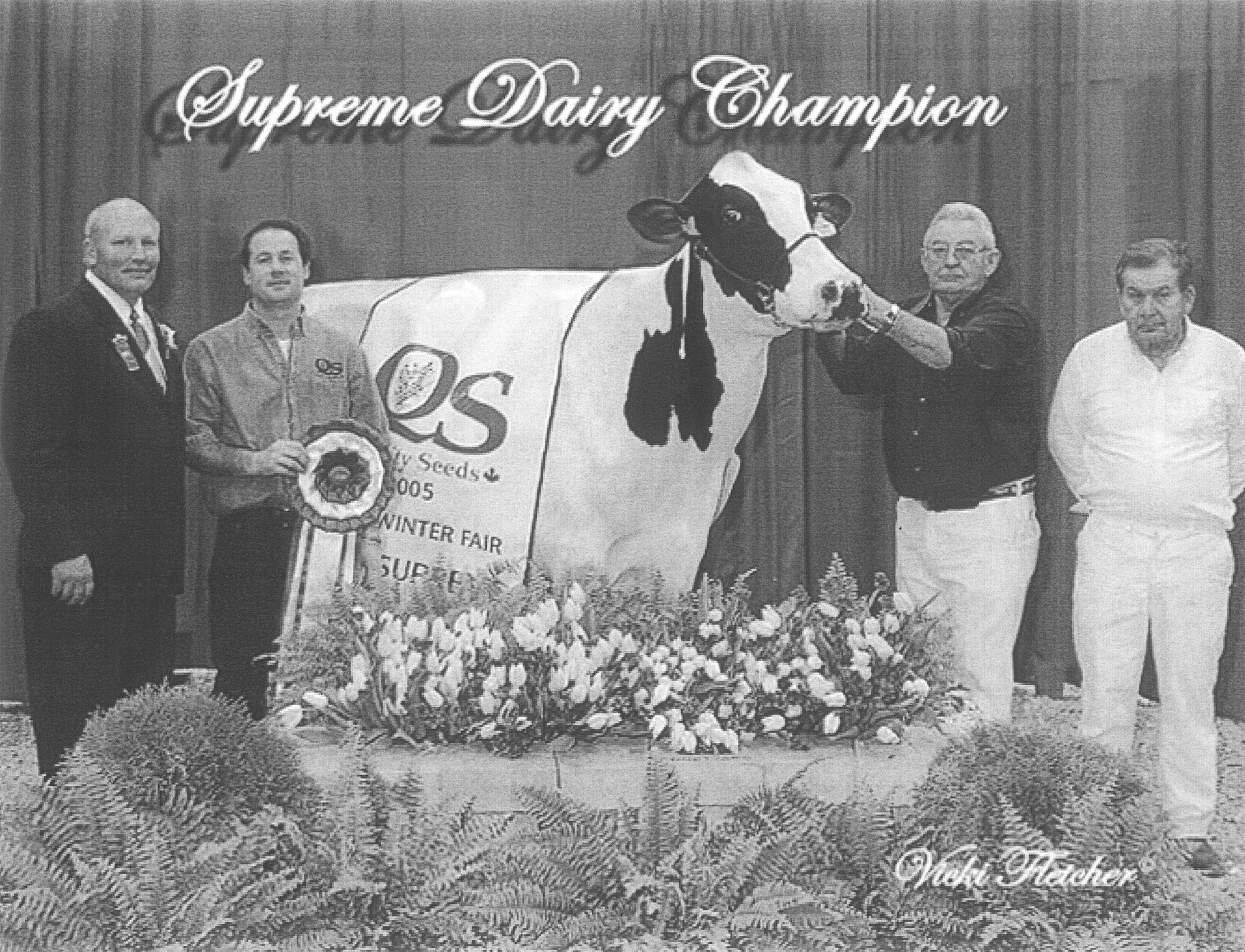
When Joel Lepage points to Grand Champions next Friday, when people pause at Ari’s tribute poster to remember Paul, when these six operations walk their cattle into the ring, those gestures will represent more than one day’s achievement. They’ll validate decades of decisions made before dawn, sacrifices nobody saw, and the courage to keep pursuing excellence even when your heart is breaking.
But here’s what covering The Royal all these years has taught me: every one of these operations has already won. They’ve proven that legacies don’t die with their founders. They’ve shown that passion can build sustainable businesses. They’ve demonstrated that in an industry of increasing scale and technology, there’s still room for operations driven by conviction and love.
Next Thursday and Friday at The Royal Winter Fair, we won’t just watch cattle being judged. We’ll witness what happens when dreams collide with reality, when preparation meets opportunity, when the next generation carries forward what the previous generation built.
The banners will be awarded. Champions will be crowned. But this year, with Paul’s spirit present in his absence, with multiple generations showing together, with dreams both fulfilled and still pursued, The Royal means something more.
It’s proof that some things can’t be stopped. Not by loss. Not by markets. Not by time itself.
Just farmers, their families, their cattle, and dreams that refuse to die.
That’s already victory enough.
KEY TAKEAWAYS:
- The empty chair that fills the barn: After 70 consecutive Royals, Paul Ekstein’s absence makes his legacy more present than ever—proving that true excellence transcends loss
- Six operations, zero excuses: From Kingsway’s grade herd beginnings to Westcoast’s thousands of cows, these operations prove that excellence isn’t about resources—it’s about refusing to quit
- Decades beat data every time: While others chase genomic shortcuts, operations like Ferme Jacobs (cow families first) and Quality (95% homebred) prove that time and consistency create lasting genetics
- Dreams outlive dreamers: With foundation cows like Arangatang gone but granddaughters competing, The 2025 Royal shows how excellence passes through generations—in cattle and families alike
- Your farm’s lesson: Whether you’re breeding for your herd or building a business, what matters isn’t your starting point but your staying power—excellence takes showing up, not showing off
EXECUTIVE SUMMARY:
Paul Ekstein attended The Royal Winter Fair for 70 consecutive years—this November, his empty chair transforms the show from competition into a testament. As his son Ari prepares Quality Holsteins’ cattle with routines his father perfected, five other elite operations bring their own dreams and losses to the ring: Kingsway pursuing their first Grand Champion after four decades, Ferme Jacobs proving cow families still trump genomics, Lalande and Boulet showing passion drives profit, and Westcoast achieving excellence at industrial scale. What unites these diverse operations isn’t philosophy but persistence—Kingsway started with grades, Quality with nothing —and both built dynasties by showing up decade after decade. This year carries extra weight as foundation animals like Kingsway’s Arangatang have passed, but their granddaughters compete, while US operations like Budjon and Triple-T remind everyone excellence knows no borders. When Judge Joel Lepage and JP Proulx evaluate cattle next Thursday and Friday, they’ll judge more than conformation—they’ll validate lifetimes of pre-dawn decisions by families who chose the harder path. The 2025 Royal proves that legacies don’t die with their founders but live on through genetics, families, and dreams that refuse to quit.
 Join the Revolution!
Join the Revolution!
Join over 30,000 successful dairy professionals who rely on Bullvine Weekly for their competitive edge. Delivered directly to your inbox each week, our exclusive industry insights help you make smarter decisions while saving precious hours every week. Never miss critical updates on milk production trends, breakthrough technologies, and profit-boosting strategies that top producers are already implementing. Subscribe now to transform your dairy operation’s efficiency and profitability—your future success is just one click away.







 Join the Revolution!
Join the Revolution!
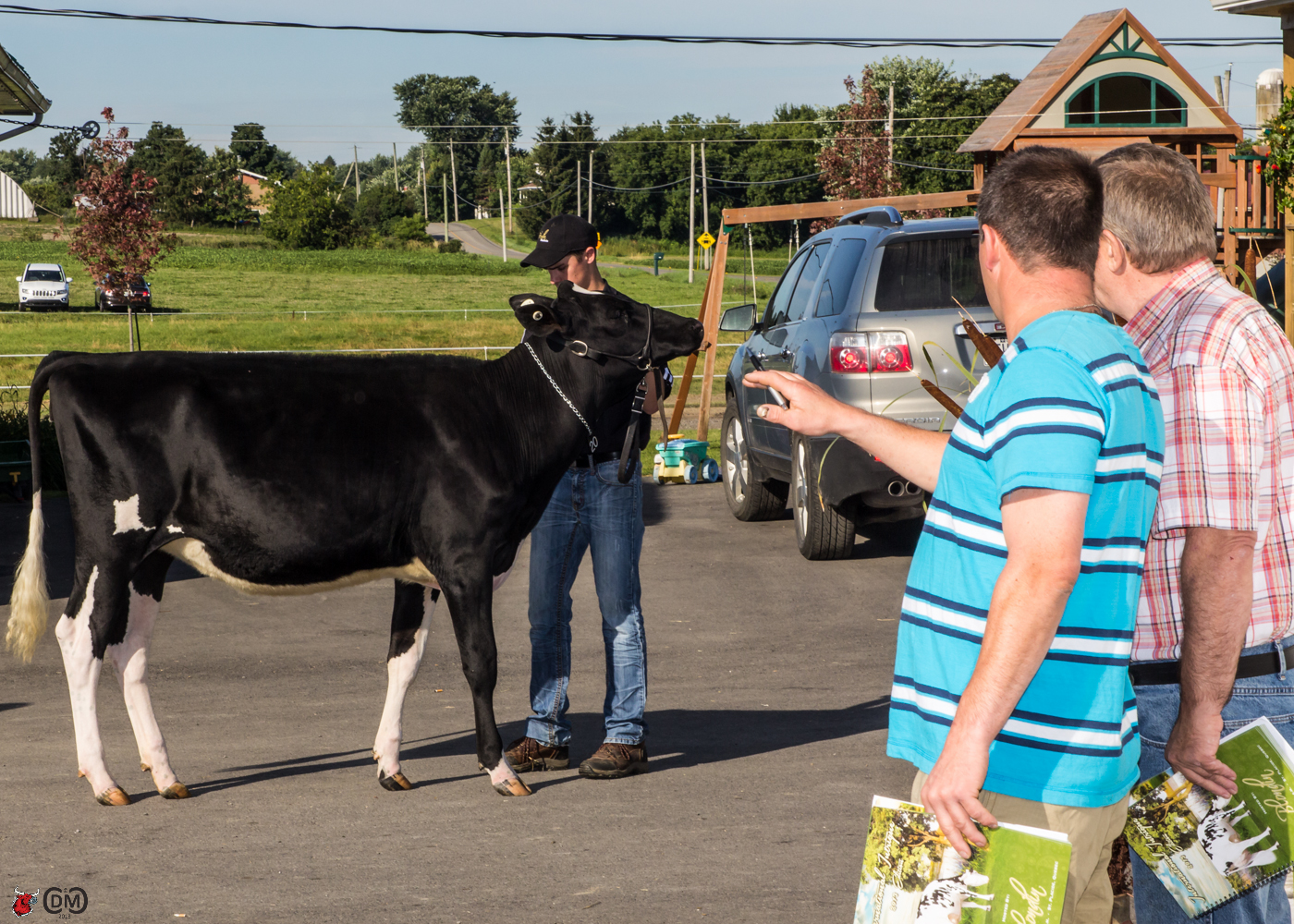
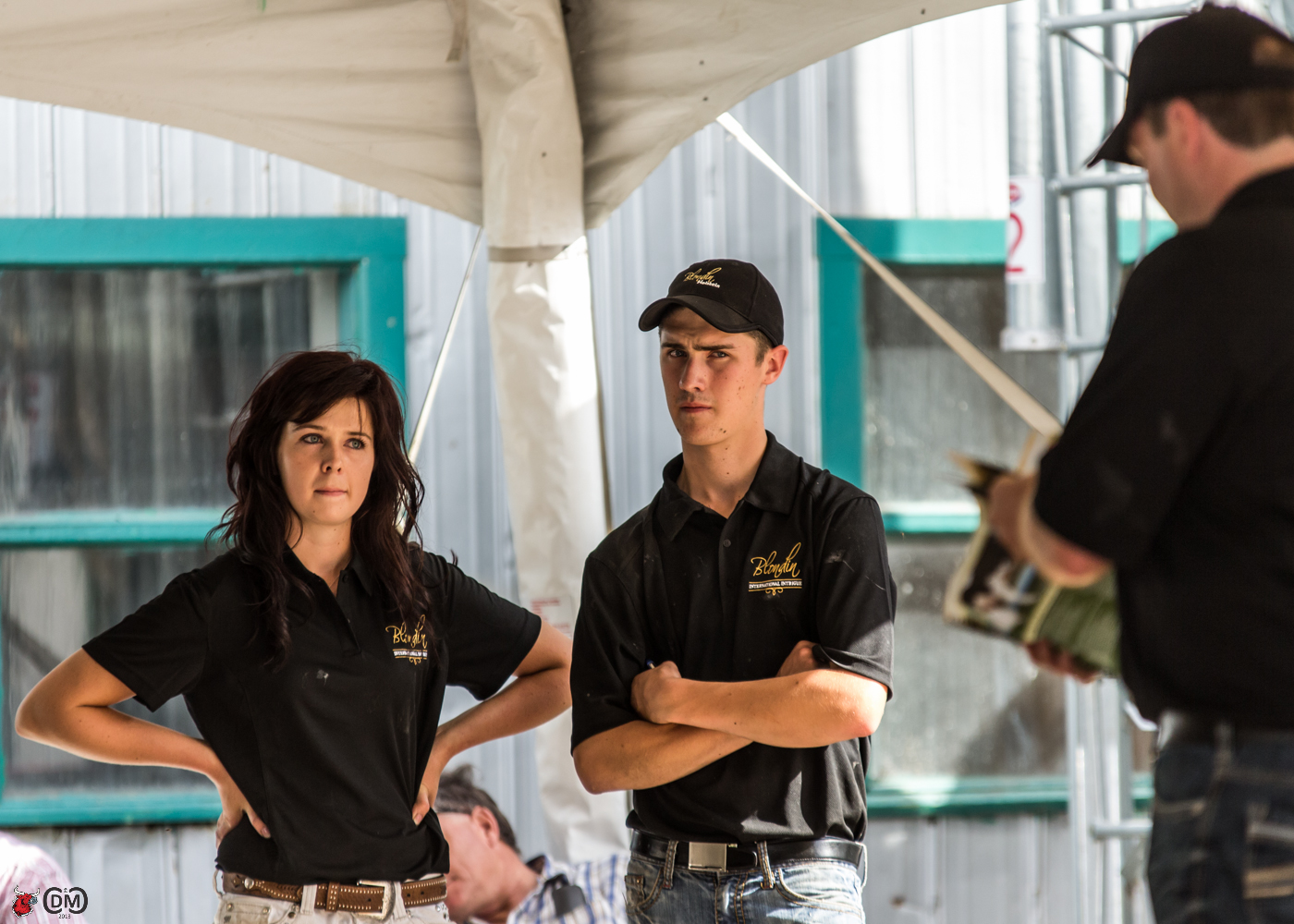
 “This cow is being stolen!” cries out Horace Backus, from the auctioneer’s box at the US National Convention sale. ‘A beautiful Jasper daughter with such a magnificent pedigree gets such a low offer – that is pure robbery!” adds Backus. Pounding his fists onto the podium, Backus has a point, since they are getting less than $5,000 for a very productive cow and moments earlier a very young calf sired by a genomic young sire sold for over $20,000. Here you have an animal already proving her profitability versus a calf that has nothing more to show for herself then a simple little test? I ask you ”Does the marketplace have it all wrong?”
“This cow is being stolen!” cries out Horace Backus, from the auctioneer’s box at the US National Convention sale. ‘A beautiful Jasper daughter with such a magnificent pedigree gets such a low offer – that is pure robbery!” adds Backus. Pounding his fists onto the podium, Backus has a point, since they are getting less than $5,000 for a very productive cow and moments earlier a very young calf sired by a genomic young sire sold for over $20,000. Here you have an animal already proving her profitability versus a calf that has nothing more to show for herself then a simple little test? I ask you ”Does the marketplace have it all wrong?”
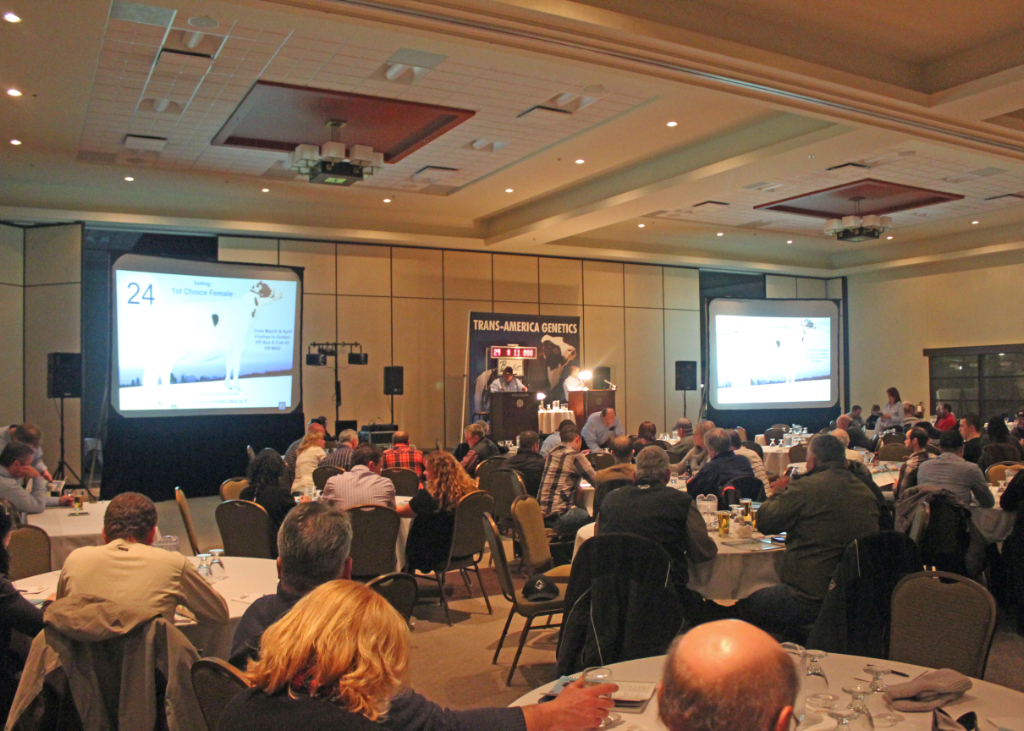 In our recent analysis of what is selling at the Canadian Auction sales of 2013, we found that high genomic animals, (animals that are over 3,000 LPI) outsold all other animals by a whopping 61%. (Read more at
In our recent analysis of what is selling at the Canadian Auction sales of 2013, we found that high genomic animals, (animals that are over 3,000 LPI) outsold all other animals by a whopping 61%. (Read more at 